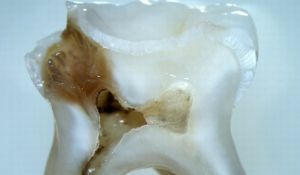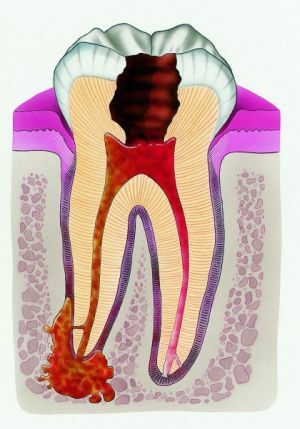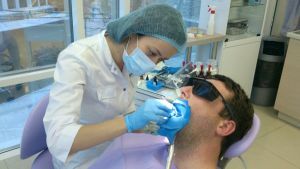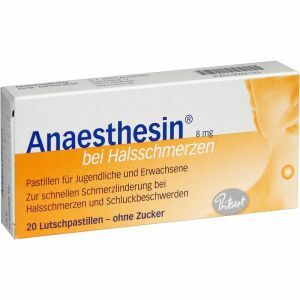 Many people are afraid to treat their teeth. For them, a visit to the dentist is a terrible procedure, during which you will have to go through all the "circles of hell".
Many people are afraid to treat their teeth. For them, a visit to the dentist is a terrible procedure, during which you will have to go through all the "circles of hell".
And this despite the fact that now dental treatment is painless, and therapy without anesthesia has long been a thing of the past. Modern medicine allows you to treat your teeth without pain, without using "terrible torture tools", in comfortable conditions.
Contents of
- A bit about toothache
- What determines how painful it is to treat teeth
- To remove a tooth without pain - is it real?
- We are treated without pain
A bit about toothache
Healthy teeth do not hurt, but if there are unpleasant sensations or even pain - there are certain reasons for this.
Let's highlight the main ones:
- Caries .Literally in Latin, this disease is translated as decay. First, a dark speck appears on the surface of the molar,
 then begins the process of destruction of enamel and pulp. Painful sensations arise when taking hot / cold, sour / sweet, as well as when entering the carious cavity of food, and are short-lived. Caries is the most common dental disease.
then begins the process of destruction of enamel and pulp. Painful sensations arise when taking hot / cold, sour / sweet, as well as when entering the carious cavity of food, and are short-lived. Caries is the most common dental disease.
- Tooth sensitivity ( or hyperesthesia).Externally, the molars look quite healthy, but a hot sandwich or ice cream can cause severe discomfort. Painful sensations can be short-lived or prolonged, intense. Such a reaction arises not only in hot and cold, but also in sweet and sour. According to statistics, every third patient of the dentist faces such an unpleasant phenomenon.
- Pulpit .This is an inflammatory process that takes place in the neurovascular bundle of the molar. Basically, pulpitis occurs as a result of "neglected" caries. In acute process, a person experiences a throbbing severe pain, which can not be "drowned out" with pills.

- Periodontitis .If you do not treat pulpitis, it will go to a more serious stage of inflammation. In this case, not only the pulp is affected, but also the connective tissue of the tooth and bone tissue. When food( chewing) falls on a sick molar, a person experiences severe pain. When acute periodontitis may appear weakness, fever and insomnia.
- Periodontitis .Parodont - these are tissues that "hold" the tooth( gums, ligaments, bone and mucous membranes).Inflammation of these tissues is called periodontitis and is the second most common after caries disease of the oral cavity. Characterized by pulsation in the gums, itching, "mobility" of teeth, hyperesthesia.
- Teeth of wisdom .Many have heard that the growth of the "eights" is accompanied by a strong discomfort. If the wisdom teeth are located correctly and healthy, then they will not cause any problems to the person. However, often with eruption of eights complications arise. The most common problems are inflammation of the tissue around the molar or the appearance of a "hood", a malocclusion, pressure on an adjacent molar, inflammation of the ternary nerve and other troubles. All this leads to pain of varying degrees of intensity and strength.
What determines how painful it is to treat teeth
The term "treat the teeth" means a whole range of dental services - from filling the molar to prosthetics.
Some procedures will be absolutely painless, and some will bring some discomfort to the patient.
Ideally, a person should visit a dentist once every six months. The doctor can see the initial stage of enamel changes( demineralization) and prevent the appearance of carious cavities.
 At this stage, the treatment is completely painless. Special solutions are applied to the surface of the tooth, and after a number of procedures the problem with the teeth will be prevented.
At this stage, the treatment is completely painless. Special solutions are applied to the surface of the tooth, and after a number of procedures the problem with the teeth will be prevented.
If you can not prevent tooth decay, then it will have to be treated with tools. At an early stage, removing the destroyed enamel will not cause any unpleasant emotions.
But if the tooth decay is "deepened" on the surface of the tooth, the dentist will already use the drill. And even at this stage, treatment is rarely painful. Basically, people are more afraid of the sounds of a drilling tool than are experiencing pain.
Whether it will hurt to drill teeth depends on the degree of development of caries, the anesthesia used and the professionalism of the doctor.
Medium and deep caries are treated with anesthesia. Without its application, the sensations would already have been unpleasant. Modern drills are made from alloys with diamond dusting, so the dentist minimally injures intact molar tissue.
To treat the same teeth with an injection of anesthetic is not painful - the use of an anesthetic eliminates the pain reaction when cleaning the carious surface.
If the pulp is damaged in most cases, the nerve is removed and the channels are cleaned. Previously, dentists used to treat pasta with arsenic.
A paste was placed in the carious cavity, a temporary filling was inserted, and a few days later the nerve was removed. Now the doctors, using anesthesia, clean the canals cleanly.
To remove a tooth without pain - is it real?
The most "terrible" procedure according to the version of patients of stomatology - extraction of teeth. As in previous cases, the doctor with such manipulation  uses effective pain medications.
uses effective pain medications.
In difficult cases( for example, the tooth is misplaced or not cut), the removal of the molar can be performed under general anesthesia.
After the procedure, a person several days( and sometimes longer) may experience pain in the area of the socket of the remote tooth, rarely - deterioration of general health and inflammation of the oral cavity. In such cases, a visit to the doctor is required.
We are treated without pain
At present, modern medical preparations are used in the treatment of teeth, due to which any procedures will be absolutely painless.
The physician will select the anesthesia appropriate to the manipulations performed. In stomatology apply 4 types of anesthesia: 
- Application .This anesthesia is a form of local anesthesia. The mucous membrane of the oral cavity is impregnated with a special preparation( Tetracaine, Pyromecaine, Lidocaine, Anestezin, propolis alcoholic infusion).The duration of such anesthesia is short-term - 15-20 minutes. It is used for removing tartar, opening the suppuration, removing milk teeth, fixing the crowns, etc.
- Infiltration .This method is the most popular in dentistry. With such anesthesia, a blockade of nerve impulses is performed at the injection site( anesthetics of the firms Ultracain, Septanes, Lidocaine with epinephrine) are used. After the administration of drugs, anesthesia begins within 3-5 minutes. The duration of their action is about an hour.
- Conductor .This type of anesthesia is widely used not only in dentistry, but also in other areas of medicine. Preparations are introduced into the area of the ternary nerve. The duration of anesthesia is 1.5-2 hours. This kind of anesthesia is used when removing teeth, treating gums or with a vast area of simultaneous treatment.
- Stem .This method is used rarely and only in a hospital. Used for injuries, severe pain syndrome, operations on the jaw, neuralgia.
In some people, anesthetics cause allergies, but this is no reason to experience pain in the dentist's office. There are alternative methods of dental treatment:
- laser preparation of the affected molar,
- chemical treatment of the tooth with a solvent.
Thus, with the right choice of anesthesia by a doctor, dental treatment can be absolutely painless.
